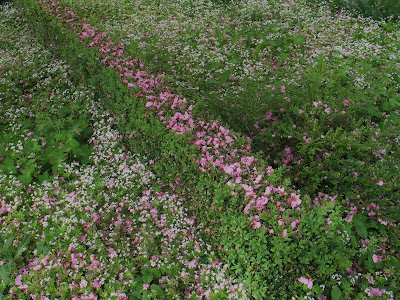The Shooting Star, Dodecatheon meadia, grows among the Phlox
While the
Prairie Smoke makes the savanna, the
Phlox rules in the Woodland in Laholm and turn it into a spectacular color satisfied place. There are two different species of Phlox in the woodland,
Phlox divaricata, the Blue Woodland Phlox, also known as Wild Sweet William and
Phlox stolonifera, Creeping Phlox, both native to rich woodlands in the Appalachian Mountains in Eastern USA.
Phlox divaricata grows with upright stems crowned by scented flowers in pale blue or white.
Phlox stolonifera does not smell much, but it covers the ground well with creeping sterile shots. There are many named cultivars with different shades from bright pink, soft lilac, deep violet to pure white.
Shooting Star, Phlox stolonifera and Phlox divaricata in harmony
Planted in masses the scent from the blue Phlox divaricata is overwhelming
Fothergilla major flowers with its cute whitish wads
Osmunda cinnamomea is in my opinion maybe the most beautiful of all hardy ferns you can grow in your garden. It prefers a moist site in shade or dappled sunlight. Slightly acid to acid conditions and a soil with some organic matter is best.
If you can also find a sheltered place in the woodland with high humidity you have made the best situation for this green fellow. The sterile foliage makes a nice, open wreath and in the middle of it the erect fertile leaves emerges. In the autumn this fertile leaves turn into a striking cinnamon brown shade. Also the sterile leaves have reddish brown fall colors.
Osmunda cinnamomea is shoting in late spring and early summer


































